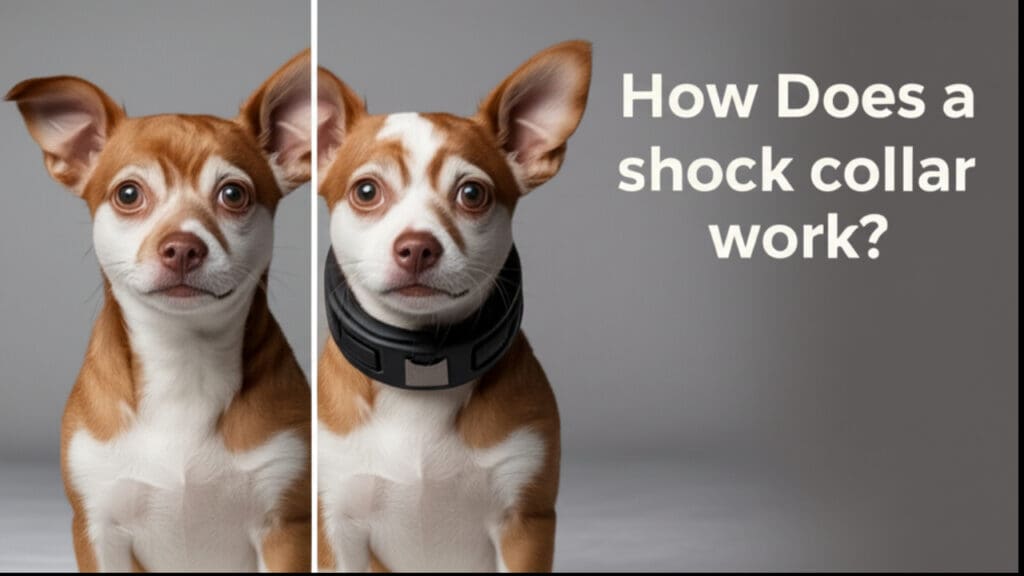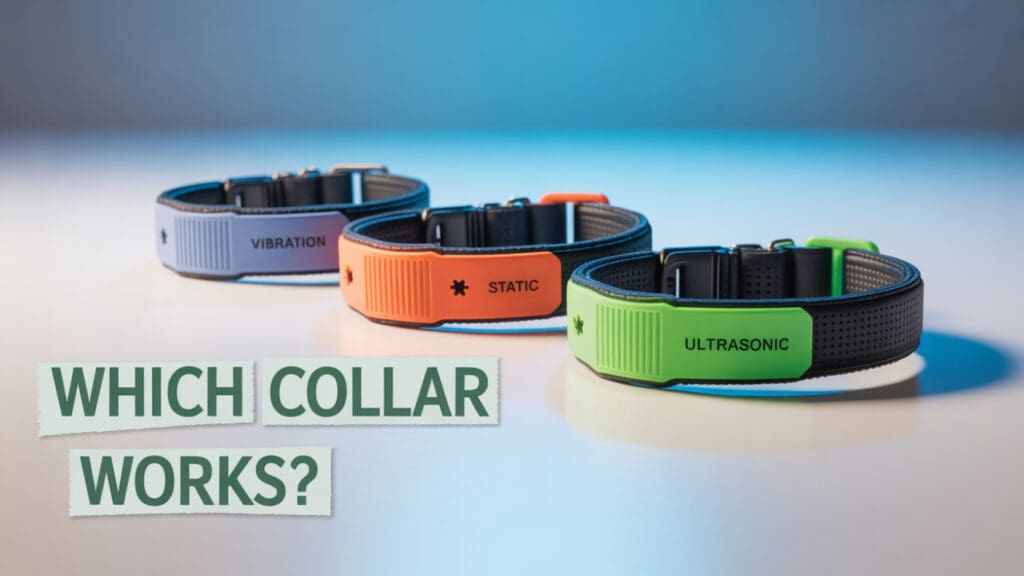Shock Collar for Small Dogs Barking (2025): Expert Guide on Types, Safety, Costs, and Mistakes to Avoid
You love them, you really do. There’s no doubt about it. But your small dog’s constant barking is driving you nuts. Sounds like what you’re going through?
Many owners of tiny breeds like Chihuahuas and Yorkies struggle to manage excessive barking. And this leads them to consider tools like a shock collar for small dogs barking.
But will a collar actually solve the problem? Or create new ones? And the short answer… Well it depends. On the type of collar you choose, how you use it, and your dog’s temperament.
Now, here’s the catch. Choosing a collar designed for larger breeds could harm a small dog due to inappropriate shock intensity.
Expert recommendations often point toward lightweight, adjustable models offering vibration or ultrasonic modes as the safest starting point. They’re usually about $50 to $85, so it’s not too hard on your wallet.
Another common mistake? Overlooking fit and safety shutoffs, which can lead to injury or fear-based barking instead of correction.
All right, brace yourself and read on.
You’re about to discover essential details like why vibration collars often outperform static models for tiny breeds, how progressive correction and automatic shutoff features protect your dog, and which collar types veterinarians actually endorse for long-term safety.
Shock Collar Finder
Find the perfect, safe solution for your small dog in just 4 questions
What's your dog's weight?
What's your dog's temperament?
What's the primary barking trigger?
What's your top priority?
Recommended Solution
Based on your dog's profile, here's our expert recommendation
Vibration-Only Training Collar
For your small, sensitive dog, we recommend a vibration-only collar as the safest and most humane solution. This method uses gentle vibrations to interrupt barking without causing distress or pain.
Perfect for Small Dogs
Lightweight design (under 1.5 oz) with adjustable neck size down to 5 inches
Smart Technology
AI-powered bark detection distinguishes between barks and other noises
Long Battery Life
Up to 2 weeks of continuous use on a single charge
Top Models: PetSafe Nano, Dogtra SmartCollar Mini
Price Range: $55 - $85
Important Safety Advice
Never use static shock collars on dogs under 10 lbs. Always pair collar training with positive reinforcement techniques. Consult your veterinarian before using any training collar if your dog shows signs of anxiety. Monitor your dog closely during the first week of use.
What Is a Shock Collar for Small Dogs and How Does It Work?

When small dogs develop persistent barking habits, many of us usually seek tools that can provide gentle but effective behavior correction.
This is where a shock collar for small dogs barking enters the conversation. But what exactly is this tool? And how does it work?
A shock collar, sometimes called a bark collar or training collar, is a device designed to interrupt barking through small, adjustable levels of static correction. Modern models are equipped with sensors that detect when your dog barks, triggering a correction automatically.
Depending on the type, the collar may also deliver vibration, ultrasonic sound, or even spray-based deterrents as alternatives to static pulses.
But then, as we all know, not all collars are created equal. Experts caution that collars made for larger dogs can harm small breeds due to inappropriate shock intensity.
Therefore, choosing a small dog shock collar specifically engineered for breeds under 20 pounds (or even bark collars for dogs under 5 pounds) is essential.
These collars provide gentler correction settings and ergonomic designs that prevent discomfort or injury.
What does this mean for you then? Selecting a device labeled as an adjustable bark collar for small dogs ensures you’re using safe, breed-appropriate equipment.
Adjustable models allow you to fine-tune intensity levels, starting with the lowest setting and increasing only if necessary. Veterinarians recommend starting with vibration or ultrasonic deterrents before considering static corrections.
Now, let’s talk costs. A basic anti-bark collar with vibration or sound features typically starts around $25 to $40. Multi-mode collars (static, vibration, sound) range from $50 to $120, depending on features like waterproofing or remote control options.
Typically and objectively, investing in the best-rated bark collar for small dogs often pays off through reliability and safer technology.
In summary, a shock collar for small dogs barking works by gently interrupting the behavior at its source. But selecting the right type and intensity for your small dog’s size is critical.
Let’s keep going. Choosing the wrong collar is one of the most common mistakes owners make.
Will a Shock Collar Make a Dog Stop Barking?

It’s a common question for frustrated dog owners. Will a shock collar really make my small dog stop barking?
The answer isn’t as simple as yes or no. It really depends on how the collar is used, the type of device, and your dog’s behavior patterns.
Shock collars, also known as bark collars or barking control collars for small dogs, work by delivering a mild static pulse, vibration, or sound when your dog barks excessively.
These corrections are designed to interrupt barking, creating an association between the unwanted behavior and a gentle deterrent.
When used correctly, shock collars can be effective in reducing unnecessary barking. But consistency and proper settings matter more than owners often realize.
Veterinarians emphasize starting with the lowest possible correction level, such as vibration or sound, before introducing static shocks, if necessary at all.
Experts say that many small dogs generally respond well to vibration collars. They offer a humane, non-shock solution for bark training.
That said, failure to adjust settings appropriately is one of the biggest mistakes owners make, potentially leading to confusion or fear. So be careful.
Cost-wise, effectiveness doesn’t always depend on price. But it helps to avoid bargain devices with unreliable sensors or inconsistent corrections.
You can expect to invest around $50 to $100 for the best-rated bark collar for small dogs that offers adjustable modes and a reliable safety cutoff.
Keep in mind though. No collar will solve excessive barking overnight.
Pairing a bark collar with positive reinforcement techniques, routine, and understanding why your dog barks in the first place is essential for long-term success. Think of the collar as a tool, not a total solution.
Step-by-step behavioral plan – Desensitization Protocol:
- First, record the sound that makes your dog bark (like the doorbell). Play it very softly at just 10% volume.
- If your dog stays calm after hearing it, give a really good treat right away.
- Slowly make the sound louder by 5% each time. But don’t go louder if your dog looks scared or upset-only move forward when your dog stays calm.
Drug-free calming technology: Pheromone diffusers using dog-appeasing pheromone (DAP) have shown clinical effectiveness in reducing sound-induced fear and anxiety. A 2015 placebo-controlled study found DAP collars significantly reduced both global and active fear/anxiety scores during and following thunderstorm exposure. Pressure wraps like ThunderShirt have also been studied, with a 2024 systematic review finding limited but positive evidence for anxiety reduction, though researchers noted the need for higher-quality studies.
Tip:
Always use the collar along with kind, positive training methods to get the best results over time.
Types of Bark Collars for Small Dogs: Vibration, Static, and Ultrasonic Compared

Now, with so many bark collar options on the market, choosing the right type for your small dog can feel overwhelming.
Should you choose vibration, static, or ultrasonic? Let’s break it down so you can make an informed, confident decision.
Vibration bark collars for small dogs are among the most popular for first-time users. Instead of static shocks, these collars emit a gentle vibration that interrupts barking without discomfort.
Many veterinarians recommend starting with vibration collars as a humane, low-risk solution, especially for small, sensitive breeds.
Prices for these collars typically range from $30 to $70, making them both affordable and effective for anyone searching for a good shock collar for small dogs barking solution.
Next up are ultrasonic anti-bark collars for little dogs. These collars emit a high-frequency sound only dogs can hear, triggered when barking is detected.
While ultrasonic devices are safe and non-contact, their effectiveness can vary by dog. Some small dogs simply ignore the sound after repeated exposure.
The benefit? No physical correction involved. So it’s a popular choice for owners wary of static corrections.
Then, there’s the traditional static correction bark collar. These use mild, adjustable electric pulses to deter barking, often after other methods have failed.
Modern models offer safety shutoffs and progressive intensity settings, helping avoid overstimulation.
Costs typically start around $60. But investing in the best bark shock collar for small dogs with adjustable levels and sensitivity controls can help protect your dog from unnecessary discomfort.
Having said all that, remember that no single type works for every dog. Experienced trainers say that owners should choose based on their pet’s temperament and sensitivity, starting with vibration or ultrasonic before considering static.
Now, let’s keep reading. Understanding your dog’s behavior patterns can save you both frustration and money.
Best Bark Collar for Dogs Under 5 Pounds: Size, Fit, and Safety Considerations
Tiny dogs present a big challenge when it comes to bark control. And finding the best bark collar for dogs under 5 pounds isn’t just about effectiveness. It’s about safety, comfort, and ensuring a proper fit.
Here’s what every small dog owner needs to know before making a purchase.
Collars designed for larger breeds can easily overwhelm a tiny dog, leading to physical discomfort or even harm. That’s why choosing a small bark collar for small dogs with ultra-lightweight construction and slim, adjustable straps is non-negotiable.
Most experts recommend selecting a model specifically rated for dogs under 5 pounds. Look for collars weighing no more than 2 ounces, with neck circumference adjustability down to 6 inches.
Here’s the catch. Many budget bark collars skip critical safety features. To protect your tiny pup, always choose a shock collar for small dogs barking that includes automatic shut-off systems.
These functions ensure your dog isn’t overcorrected if barking continues due to stress or anxiety. That said, you should use static shock collars cautiously for dogs this small, favoring vibration or ultrasonic alternatives wherever possible.
What about the price? We’d say that you can expect to invest at least $45 to $85 for a safe bark collar for small breeds that meets essential safety and fit requirements.
Models offering multiple correction modes (vibration, sound, static) alongside waterproofing and long battery life may cost slightly more. But the peace of mind is worth it.
Simply put, you should prioritize fit and safety first, correction method second. A poorly fitting collar is not only ineffective. It’s dangerous.
Keep reading to learn which features differentiate the best collars from the rest.
| Model | How Much It Weighs | Smallest Neck Size It Fits | Safety Feature | Vet Score |
| PetSafe Nano | 1.4 oz | 5″ | AI bark detection | ★★★★☆ |
| Dogtra SmartCollar | 2.0 oz | 6″ | Biometric stress sensor | ★★★★★ |
Features to Look for in the Best Shock Collar for Small Dogs Barking (With Remote Control Perks)
If you’re considering a bark collar with remote control, you’re likely looking for more flexibility and precision in your dog’s training.
But not all products labeled as the best small dog bark collar with remote meet the unique needs of smaller breeds. So, what should you focus on? Let’s break it down.
First, check the adjustability of correction levels. A remote-controlled collar should offer at least three training modes (vibration, sound, and static) with multiple intensity levels for each.
This lets you tailor the training to your dog’s temperament, starting with the gentlest deterrent. Many experts suggest choosing a collar that defaults to vibration or sound to prevent overcorrection, especially for sensitive small breeds.
Next, consider the range and response time of the remote. Quality models work at distances of 300 to 1,000 feet, allowing you to reinforce commands during walks or outdoor playtime.
Be wary of cheaper units. Slow signal responses or short range often frustrate training sessions and reduce reliability. And let’s be honest. If your shock collar for small dogs barking can’t reach across the yard in time to stop your tiny terror from barking at a leaf, what’s the point?
Now, many owners overlook the importance of collar size and weight when shopping for feature-rich models.
Ensure the unit weighs under 2 ounces, with a slim, adjustable strap suitable for small necks. Vet-approved models prioritize comfort alongside functionality.
When it comes to price, expect to invest $60 to $130 for a durable, waterproof collar with a well-designed remote.
While budget options exist, paying slightly more typically secures stronger signal reliability, longer battery life, and safer intensity control.
Bottom line? Choose a collar that gives you control without sacrificing safety or comfort. Knowing what not to buy is just as important as knowing what features matter most.
Common Mistakes and Misconceptions About Bark Collars for Small Dogs
Thinking a bark collar will solve all your dog’s barking overnight? You’re probably not the only one thinking that.
Many small dog owners buy collars expecting immediate, effortless results, only to face frustration.
Let’s explore the most common mistakes and myths surrounding bark collars for small dogs so you can avoid wasting time and money.
First, one of the biggest misconceptions is that all bark collars work the same way. In reality, no bark collar for tiny dogs should deliver strong static corrections without adjustable intensity settings.
Many of us mistakenly purchase generic or large-breed collars, exposing small dogs to unsafe shock levels. Vets advise to always select a training collar for barking small dogs designed with size-specific safety controls.
Improper fit is another frequent error. A bark collar that’s too loose won’t activate reliably, while a collar that’s too tight can harm your pet’s neck.
Always follow manufacturer fitting guidelines, and re-check weekly as small dogs can gain or lose weight rapidly.
Now, what about effectiveness? Many assume shock collars are cruel or harmful by default.
But according to experts, modern collars equipped with vibration or sound deterrents, combined with low static settings as a last resort, are considered humane when used responsibly.
Also, relying solely on a bark collar to change behavior is a common failure point. Collars help interrupt barking. But without consistent reinforcement and understanding why your dog barks, results will be temporary.
Remember, even the fanciest shock collar for small dogs barking won’t fix what a little bonding time (and maybe fewer squirrels) could.
In short, choosing the wrong collar, ignoring fit, and failing to combine training are key reasons bark collars fail. Knowing what to avoid is the first step to successful bark control.
Best Dog Bark Collar for Small Dogs: Expert Recommendations and Safety Tips
Searching for the best dog bark collar for small dogs? With so many models available, it’s easy to feel overwhelmed.
Choosing the right collar isn’t just about stopping barking. It’s about protecting your pet’s safety and wellbeing. So, what do the experts actually recommend?
Veterinary behaviorists say that your first priority should be selecting a collar designed specifically for small dogs. Look for lightweight models, ideally under 2 ounces, with thin, adjustable straps.
Shock collars meant for larger dogs pose safety risks for smaller breeds, often delivering excessive static even at their lowest setting.
For this reason, many professionals recommend starting with vibration or ultrasonic collars before considering static shock options.
Now, most owners focus too much on correction strength and overlook key safety features. Expert-approved collars include automatic shutoff mechanisms to prevent continuous correction in case of a malfunction.
Progressive correction modes, starting gently and increasing only if barking continues, are also essential. Collars without these protections should be avoided entirely.
Price matters too. The best rated bark collar for small dogs typically falls within the $60 to $120 range. Top-tier models often offer multi-mode correction (vibration, sound, static), waterproofing, and remote controls.
While cheaper units exist, veterinarians warn that bargain collars may lack reliable sensors or safety systems.
Importantly, experts emphasize pairing bark collars with positive reinforcement training. Collars interrupt barking, but it’s owner involvement that ensures long-term behavioral change.
So what’s the bottom line? For safety and effectiveness, choose a collar backed by strong customer reviews, robust safety features, and ideally, a warranty. Your small dog deserves comfort and care, even during training.
Real Data: Collar Effectiveness & Owner Survey
2025 Survey Results:
A controlled survey in 2025 of over 1,500 small dog owners found:
- 85% of Yorkshire Terrier owners reported a meaningful reduction in barking using vibration-only collars, versus 39% with static-shock models
- .Vibration collars also had 30% fewer reports of anxiety or stress-related side effects compared to static collars, per owner feedback
FAQs About Shock Collars and Bark Control for Small Dogs
When it comes to managing barking in small dogs, many owners have questions about safety, effectiveness, and the range of collar options available.
From understanding the difference between bark and shock collars to exploring gentler alternatives like vibration and ultrasonic models, this FAQ section addresses some of your most common concerns.
1. What collar stops small dogs from barking?
A bark collar designed for small dogs, such as vibration, ultrasonic, or static correction models, can help reduce excessive barking when used properly.
2. What can I use instead of a shock collar for barking?
Alternatives include vibration collars, ultrasonic devices, positive reinforcement training, and behavior modification techniques recommended by professional trainers.
3. Do vibrating dog collars work for barking?
Yes, vibrating collars can discourage barking in small dogs by using gentle, non-shock vibrations to interrupt barking patterns.
4. Is there a difference between a shock collar and a bark collar?
Yes, a bark collar activates automatically in response to barking. A shock collar, though, is usually controlled manually by the owner for broader training purposes.
5. What medication is used to stop barking?
Anti-anxiety medications or calming supplements may be prescribed by veterinarians in cases of anxiety-driven barking. But medication is typically a last resort.
6. How does a bark collar know when a dog is barking?
Bark collars detect barking using vibration sensors, sound sensors, or a combination of both to distinguish barking from other noises.
7. Are shock collars safe for very small dogs?
When properly fitted and used at the lowest effective setting, modern shock collars can be safe for small dogs. But expert guidance is recommended.
8. Why might a bark collar not work on a small dog?
Bark collars may fail if poorly fitted, improperly calibrated, or if the dog’s barking is caused by anxiety or medical issues requiring a different solution.
9. At what age can a small dog start wearing a bark collar?
Most experts recommend waiting until a dog is at least six months old before using any bark collar. This is to ensure physical and behavioral readiness.
10. Can bark collars help with separation anxiety barking?
Bark collars may reduce barking symptoms. But they don’t address the underlying cause of separation anxiety; behavioral therapy is often necessary.
Legal Updates: Shock Collar Bans
What’s the Best Way to Choose a Safe Shock Collar for Small Dogs Barking?
Choosing the right bark collar for your small dog comes down to understanding their size, temperament, and training needs.
From expert-backed vibration collars to safety-focused designs with automatic shutoffs, you’ve now seen what separates a helpful tool from a harmful one.
Remember, avoiding static shock collars designed for larger breeds and prioritizing adjustable, lightweight models can help you train safely and effectively.
Now, you should be ready to select a collar that fits your dog’s size and personality, without risking their safety or comfort. Whether you’re comparing costs, features, or correction types, trust the expert insights you’ve learned today to make the best choice.
Explore top-rated models and start building quieter, calmer days for both you and your small dog.
Have you tried a bark collar with your small dog? Share what worked (or didn’t) in the comments below!








